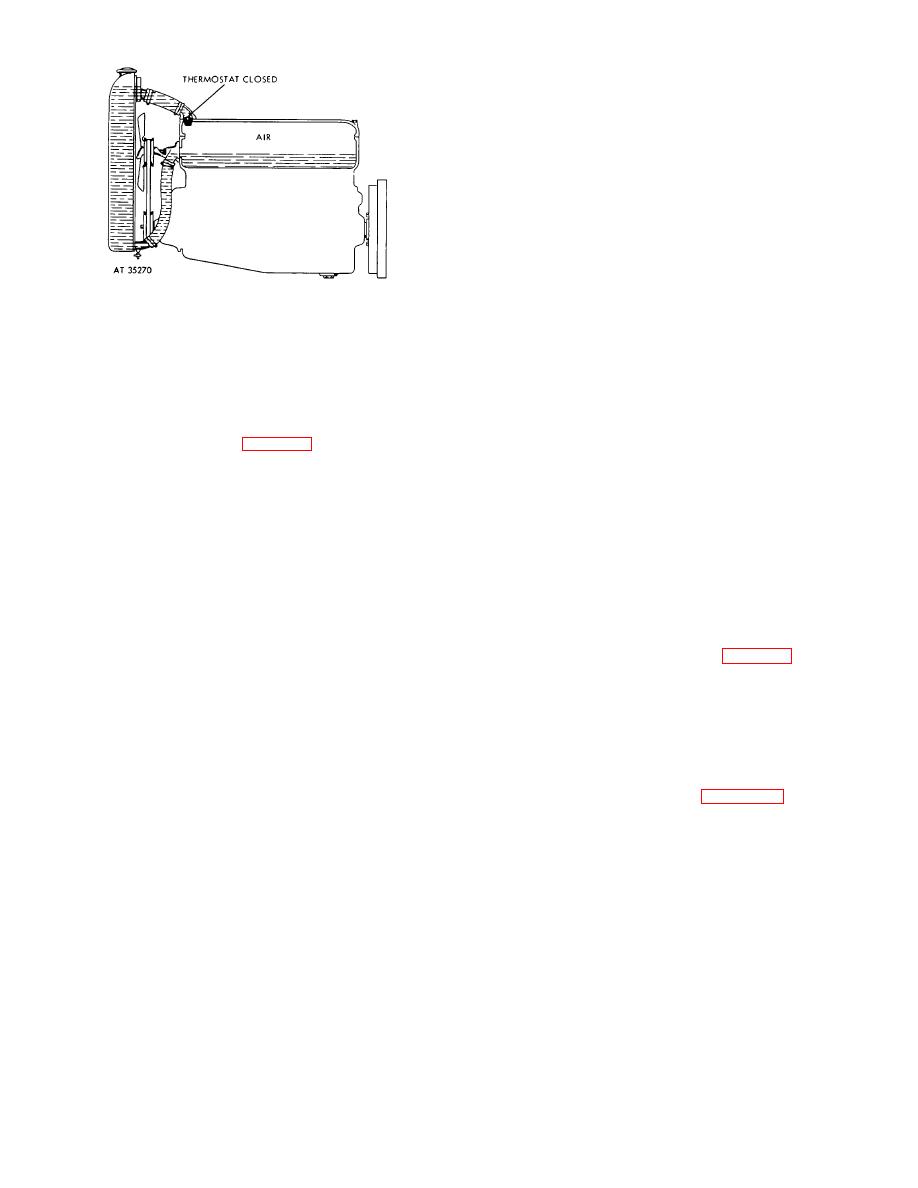 |
|||
|
|
|||
|
Page Title:
Figure 2-26. Air trapped in cooling system by thermostat being closed while system is filled. |
|
||
| ||||||||||
|
|
 2-30.
Preventive Maintenance
During scheduled maintenance services, or during climatic
change service, applicable testing of the system coolant
and inspection of the cooling system, a through c below
will be performed and recorded.
a. Testing for freeze protection, when applicable, by
use of a combination antifreeze-and-battery tester.
b. Before reading tester, hydrometer barrel should
be filled and emptied several times in order to equalize
temperature of all parts. The first number or letter on the
float above surface of the liquid is first read and solution
temperature is then noted from the first division or number,
Figure 2-26. Air trapped in cooling system by thermostat
above top of the thermometer column.
These two
being closed while system is filled.
readings should be made at the same time and as soon as
possible after drawing solution into hydrometer. Freezing
(8) With engine stopped, test freezing protection of
protection of solution is determined from float and
solution, and add water if necessary to bring coolant up to
thermometer readings by referring them to the protection
specified level Complete details on antifreeze installation
chart on the hydrometer. Tests will be inaccurate if made
procedure will be found in TB 750-651. The capacity of
immediately after adding either water or antifreeze. Most
the cooling system can be obtained from the vehicle
antifreeze hydrometers give best reading accuracy at
maintenance manual.
solution temperatures around 110F.
Even with
hydrometers designed to read at solution temperatures
below its freezing point, antifreeze solution does not freeze
below 0F, tests should always be made with temperature
solid, but a mass of small ice crystals forms in the solution.
of coolant above 60F if possible, because the solution is
The slush ice stops circulation through the radiator core.
Even after the engine is started, the slush ice may not melt
more viscous when cold. This condition prevents the float
in the radiator, due to the cold draft of air from the fan. If
from finding its true level quickly and may result in a false
operation is attempted before the radiator is thawed out,
float reading.
the engine will overheat, and steam pressure in the water
jacket will force large quantities of solution out the overflow
CAUTION
pipe. Serious heat-cracking damage may follow.
A freeze protection indication below -55F will
CAUTION
require partial antifreeze drain and replacement
Always maintain adequate freezing protection
with water and inhibitor solution (para 2-29b(3Xb)).
against the coldest weather expected.
Freeze protection must not exceed -55F.
c. Refer to TB 750-651 for testing procedures for
f.
Testing Antifreeze. To be sure that antifreeze will
reserve alkalinity.
give protection at the coldest temperature to which the
engine is likely to be exposed, and to avoid overheating
2-31.
Properties of Antifreeze
difficulties from slush freeze-up, the freezing protection of
Compound Solution
solution should be tested at least weekly and more often if
the need in indicated because of water additions or
a. Freezing Protection (fig.
Missing
weather conditions. Only hydrometers designed for testing
antifreeze compound with water lowers the freezing point
ethylene-glycol type antifreeze compound will give an
of the water in proportion to the amount of antifreeze
accurate reading. Check the accuracy of the antifreeze
compound used. The addition of 1 gallon of antifreeze
tester occasionally by taking readings on prepared solution
compound to 3 gallons of water (25 percent concentration)
of known freezing point. A mixture of one part of
lowers the freezing point of the water from +32F to +10F.
antifreeze compound and two parts of water should test to
A solution containing one-third antifreeze compound and
zero degree F, and one part antifreeze compound and one
two-thirds water will freeze at 0F, while a solution which is
part water should test to -34F. Tester manufacturers'
half antifreeze compound and half water will protect
instructions should be followed for proper use and care of
against freezing down to -34 F.
the hydrometer. Accurate readings are not possible if the
float and Inside of the glass barrel are dirty.
2-24
|
|
Privacy Statement - Press Release - Copyright Information. - Contact Us |